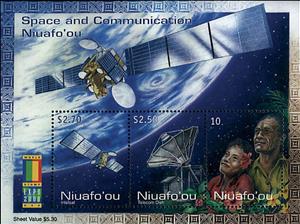Souvenir Sheet: Space and Communication (Niuafo'ou 2000)
Space and Communication (Niuafo'ou 2000)
07 July (Niuafo'ou ) within release Space and Communication goes into circulation Souvenir Sheet Space and Communication face value 5.30 Tongan pa'anga
| Souvenir Sheet Space and Communication in catalogues | |
|---|---|
| Michel: | Mi: TO-NI BL27 |
Souvenir Sheet is horizontal format.
Also in the issue Space and Communication:
- Stamp - Intelsat face value 2.70;
- Stamp - Telecom Dish face value 2.50;
- Souvenir Sheet - Space and Communication face value 5.30;
- Stamp - Wife and man watching a satellite face value 10;
Souvenir Sheet Space and Communication it reflects the thematic directions:
Communication is commonly defined as the transmission of information. Its precise definition is disputed and there are disagreements about whether unintentional or failed transmissions are included and whether communication not only transmits meaning but also creates it. Models of communication are simplified overviews of its main components and their interactions. Many models include the idea that a source uses a coding system to express information in the form of a message. The message is sent through a channel to a receiver who has to decode it to understand it. The main field of inquiry investigating communication is called communication studies.
Outer space (or simply space) is the expanse that exists beyond Earth's atmosphere and between celestial bodies. It contains ultra-low levels of particle densities, constituting a near-perfect vacuum of predominantly hydrogen and helium plasma, permeated by electromagnetic radiation, cosmic rays, neutrinos, magnetic fields and dust. The baseline temperature of outer space, as set by the background radiation from the Big Bang, is 2.7 kelvins (−270 °C; −455 °F)
A spacecraft is a vehicle that is designed to fly and operate in outer space. Spacecraft are used for a variety of purposes, including communications, Earth observation, meteorology, navigation, space colonization, planetary exploration, and transportation of humans and cargo. All spacecraft except single-stage-to-orbit vehicles cannot get into space on their own, and require a launch vehicle (carrier rocket).



